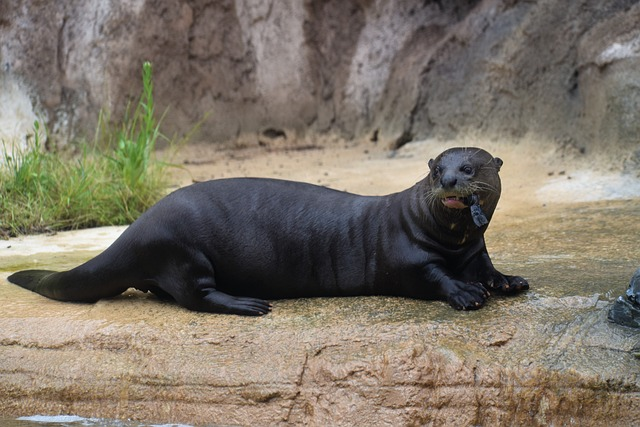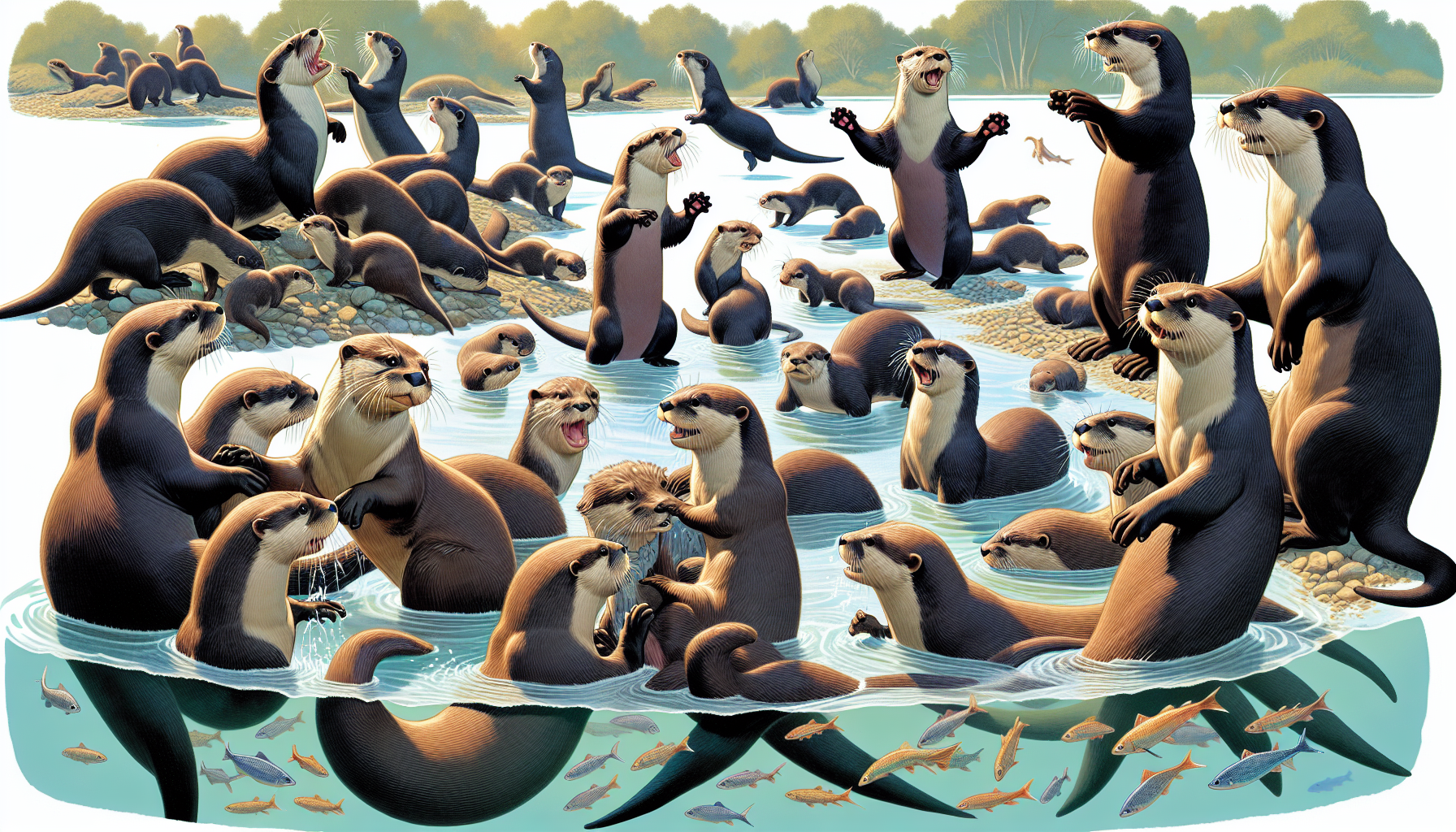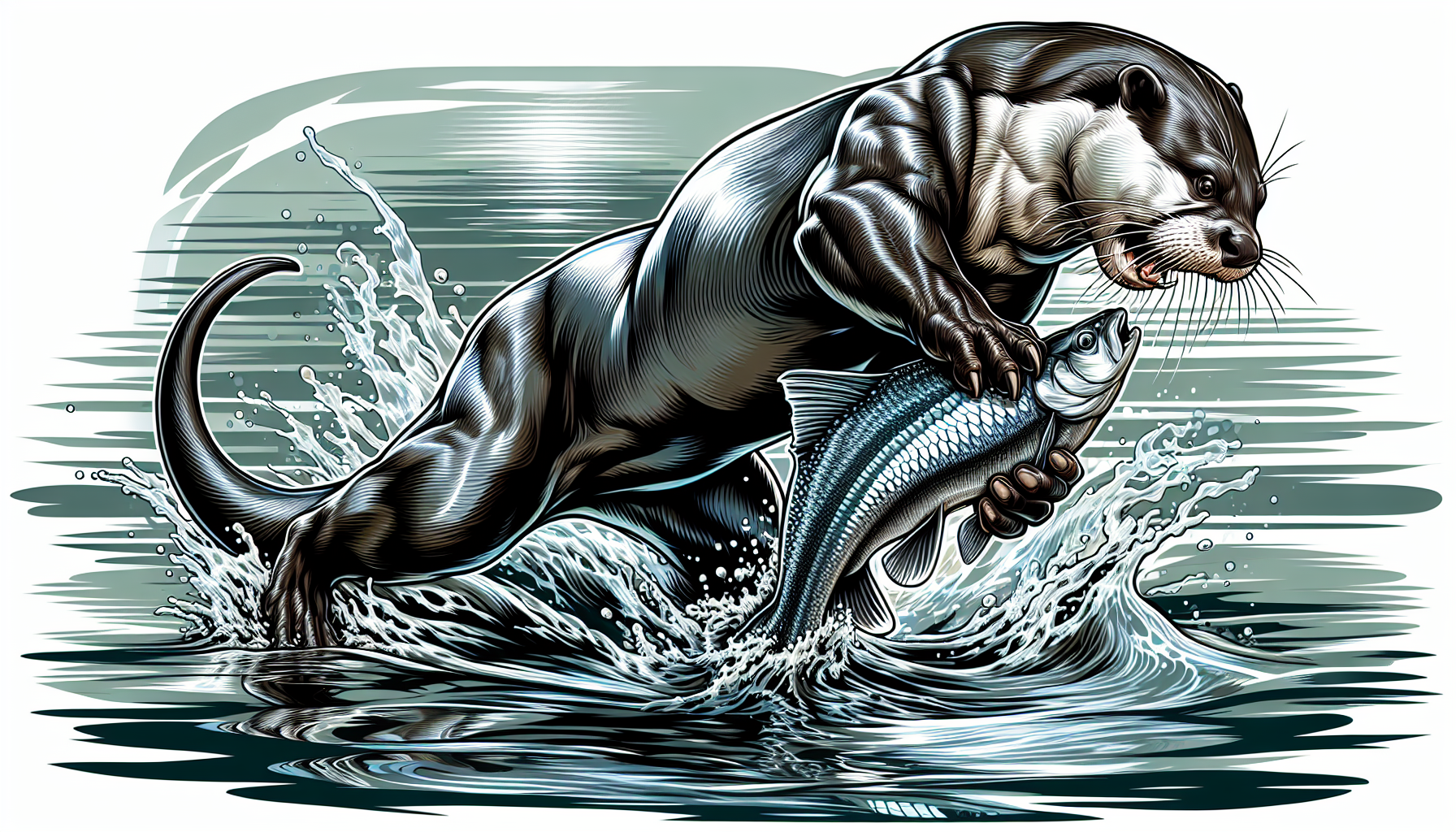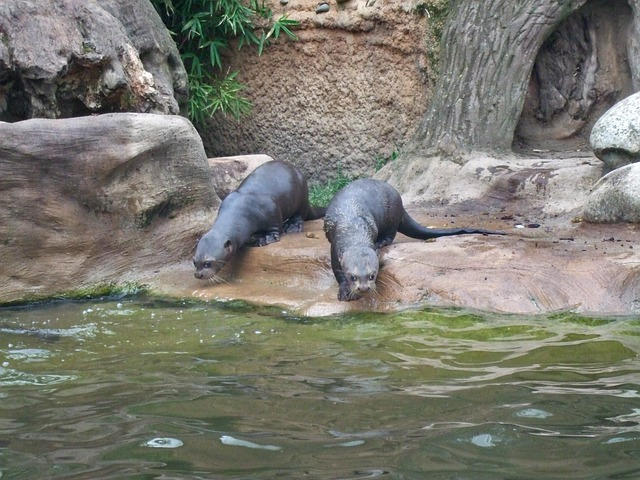Meet the giant river otter, the aquatic giant of the South American rivers. With its sleek body and sociable traits, this endangered species captures the essence of river wildlife. Journey with us as we explore its world, from striking adaptations and family bonds to the threats endangering its existence.
Key Takeaways
The Giant River Otter, scientifically known as Pteronura brasiliensis, is revered in South American culture, with different names indicating its ecological significance. It has evolved significantly regarding aquatic adaptations and exhibits distinct physical characteristics such as a dense, waterproof coat and large body size.
Giant River Otters have complex social structures built around cooperative family groups that share responsibilities and defend their territories aggressively; their diet primarily consists of fish, contributing to their role as top predators within their ecosystem.
Despite being an important indicator species for river ecosystem health, Giant River Otters face numerous conservation challenges, such as habitat degradation; there are ongoing efforts such as protected areas, monitoring, breeding programs, and legal protections to promote their well-being.
Exploring the Identity of the Giant River Otter

The Giant River Otter, also known as the Neotropical River Otter, with its scientific name Pteronura brasiliensis, holds a myriad of identities across South America, reflecting its cultural and ecological significance. Known as ‘wankanim’ among the Achuar, ‘hadami’ to the Sanumá, and ‘turara’ to the Makushi, the otter’s local names reveal deep-rooted relationships between the indigenous people and this remarkable species.
In Brazil, it’s called ‘piranha,’ meaning water jaguar, while Spanish-speaking regions fondly call it ‘Lobo de río’ (river wolf) or ‘perro de agua’ (water dog). This linguistic diversity underscores the recognition of the Giant River Otter’s role in regional biodiversity.
The Evolutionary Journey of Giant River Otters
Belonging to the Mustelid family, a diverse group of carnivorous mammals, the Giant River Otter is the sole species in the genus Pteronura. The evolutionary leap from a terrestrial weasel-like ancestor to an adaptation for freshwater habitats is a testament to nature’s ingenuity. As they transitioned towards aquatic life, both the Giant River Otters and their marine relatives, the sea otters, underwent significant genetic shifts, including:
a reduction in olfactory genes, reflecting their reduced dependence on the sense of smell underwater,
an increase in genes related to the development of webbed feet and streamlined bodies,
changes in their fur, which became denser and more waterproof
modifications to their teeth and jaws, allowing them to catch and consume fish more efficiently
These genetic adaptations have allowed the Giant River Otter to thrive in its unique aquatic environment.
A Glimpse into the Giant Otter’s Physical Traits
The Giant River Otter, renowned for its length, holds the record for the greatest body length in the mustelid family. However, size isn’t the only attribute that sets this species apart. Let’s delve deeper into the distinctive physical characteristics that contribute to the giant otter’s aquatic mastery, including its unique coat and coloration and why size truly matters for this species.
Coat and Coloration
The coat of a Giant River Otter is a marvel of natural engineering. It consists of a dense, water-repellent outer layer and a soft, insulating underlayer, a critical adaptation for an aquatic lifestyle. With the shortest fur among otter species, their velvety and dense coat is a captivating sight. It features a chocolate brown shade adorned with distinctive creamy white splotches on their throats and chests.
This unique ‘bib’ pattern adds to their distinctiveness and is vital to individual identification.
Size Matters
Steering our attention toward size, the Giant River Otter truly lives up to its name. As the world’s largest otter species and the largest member of the Mustelid family, it can reach lengths of up to 6 feet (1.8 meters). Giant otters live in the same habitat, with males typically weighing between 26 to 34 kg. In comparison, females average a slightly less weight of 22 to 26 kg, indicating a noticeable sexual dimorphism in size.
While the sea otter may boast a heavier body weight, the Giant River Otter’s more elongated body shape, marked by a pronounced tail tapering, sets it apart from its stockier sea otter counterpart.
The Social Dynamics of Giant River Otters

The social life of the Giant River Otter is as intriguing as its physical traits. Centered on a dominant breeding pair, Giant River Otter family groups, or ‘holts’, exhibit a high degree of cohesiveness and cooperation, often comprising three to eight members.
But what makes these family bonds strong, and how do these otters defend their territories? In the following subsections, let’s unravel these mysteries.
Family Bonds
Family dynamics in the Giant River Otter community testify to the adage, ‘It takes a village to raise a child.’ With a gestation period resulting in up to six pups, the responsibility of rearing the young often extends to juvenile otters in the family group, who play a supportive role by assisting the parents in raising their younger siblings.
This structured familial role distribution strengthens the bond within the group and ensures the survival and growth of new pups as parents raise younger siblings.
Territorial Behavior
Territorial integrity is of paramount importance to Giant River Otters. Groups, ranging from two to twenty members, aggressively defend their territory against various intruders, including formidable species such as:
black caimans
yacare caimans
electric eels
stingrays
piranhas
They employ scent glands, urine, and feces to mark their territory, a crucial practice because they must relocate frequently due to seasonal changes.
Despite their sociability, separate Giant River Otter groups maintain territorial boundaries and integrity through avoidance behavior, even resorting to scratching and occasional fights when defending their territories from intruders.
Diet and Hunting Techniques of Giant River Otters

Diet and hunting techniques play a significant role in shaping the lifestyle of Giant River Otters. As top predators in aquatic ecosystems, their diet primarily consists of fish, and they are equipped with specialized sensory abilities and adaptations for efficient hunting. But how do these otters locate their prey? And what are their feeding habits? Let’s dive deeper into these topics.
Predatory Skills
The Giant River Otter’s predatory prowess lies in its highly developed sensory abilities. Its sensitive whiskers, known as vibrissae, help detect changes in water pressure and currents, aiding in the localization of prey underwater. Furthermore, its sharp eyesight complements its hunting skill set by enabling it to spot prey at a distance.
These predatory skills, their ability to locate prey and their cooperative group hunting approach make them formidable hunters in their aquatic ecosystem, a prime example of predatory species.
Feeding Habits
With a high metabolic rate, Giant River Otters require a substantial amount of food, consuming 15% to 20% of their body weight daily. Their diet primarily consists of fish, including species like cichlids, perch, characins, and catfish. However, when fish are scarce, they consume crabs, snakes, and even small caimans and anacondas.
The Giant River Otters’ dietary habits and role as top predators play a critical part in maintaining the balance of the river environment and regulating the populations of prey species.
The Preferred Habitats of Giant River Otters

The Giant River Otters inhabit the river systems exclusively within the Amazon, Orinoco, and La Plata River Systems, adapting to drastic seasonal changes. But what constitutes an ideal home for these otters, and how do they adapt to seasonal changes?
Let’s explore these questions in the following subsections.
Home Construction
For a Giant River Otter, home is where the heart is, or more precisely, where the den is. These otters create dens by digging into the stable mud of river banks, constructing them with multiple entrances and chambers. These dens serve as a secure resting place and a haven for raising their young, particularly during the dry season.
Seasonal Changes
Adapting to seasonal changes is a key survival strategy for Giant River Otters. During the wet seasons, they move from their dens along rivers and ponds to flooded forests and swamps. Flooding during these seasons prevents the construction of permanent dens, prompting Giant River Otters to build temporary resting places in alternate terrains such as swamps and forests, where shallower waters facilitate easier fishing.
In the dry seasons, wild populations construct dens for resting and rearing cubs, but in the wet seasons, they abandon these dens due to flooding and build makeshift beds from shrubs.
Conservation Challenges Facing Giant River Otters
Despite their adaptability and survival skills, Giant River Otters face multiple conservation challenges that threaten their existence, primarily habitat degradation. Infrastructure development and hydroelectric dam construction have resulted in significant loss and modification of habitats critical to these otters.
Let’s explore the various conservation efforts and legal protections implemented to safeguard endangered species, focusing on these majestic creatures.
Conservation Efforts
To counter the threats to Giant River Otters, various conservation initiatives and organizations are dedicated to their protection. Some of the approaches being deployed to conserve these otters include:
Manu National Park has dedicated a zone exceeding 1 million hectares as protected land to safeguard the welfare of otters away from human disturbances.
We are monitoring programs to track otter populations and identify threats.
Captive breeding programs in zoos to help increase the otter population.
Detailed research into wild otter population dynamics to better understand their behavior and needs.
Public education initiatives to raise awareness about the importance of otter conservation.
These efforts are crucial in ensuring the survival and well-being of Giant River Otter Populations, as they help to maintain wild populations properly.
The Giant River Otter, a fascinating subject in giant otter scientific research, serves as an indicator species, reflecting the broader health of river ecosystems and further illustrating the vital nature of their conservation efforts.
Legal Protection
Protection for the Giant River Otter extends beyond conservation efforts to legal measures. Internationally, it is recognized for its endangered status and included under CITES Appendix I, protecting it from international trade exploitation.
In Peru, the Giant River Otter is officially classified as Endangered under the decree DS 004-2014-MINAGRI, reinforcing its protection at a national level.
Human and Giant River Otter Interactions
Humans play a dual role in the life of Giant River Otters, impacting them both positively and negatively. On the positive side, ecotourism initiatives contribute to sustainable environmental practices and the protection of otters. However, tensions also exist, particularly with fishermen, due to resource competition.
Let’s explore these issues in detail.
Conflict with Fisheries
The recovery of Giant Otter populations due to the prohibition of hunting has led to increased conflicts with fishermen, notably in areas like the Uacari Sustainable Development Reserve in the Western Brazilian Amazon. Fishermen have reported several negative interactions with otters, including consuming significant amounts of fish, deterring fish from usual fishing spots, and damaging fishing equipment.
The tension between fishermen and otters is not solely based on competition for resources but also on entrenched local prejudices against otters, with conflict intensifying during periods of high water that coincide with lower fishery incomes as both try to catch fish.
Cultural Significance
Despite the conflicts, Giant River Otters are significant cultural figures in indigenous folklore and traditions. Indigenous groups across South America have various folklore stories involving the otter, highlighting its integral role in their cultural heritage.
For instance, the Achuar people of Ecuador and Peru consider Giant Otters to be a form of tsunki, or water spirits, in their folklore.
The Role of Zoos in Giant River Otter Conservation
Zoos play a vital role in the conservation of Giant River Otters by providing safe environments for captive breeding programs and raising awareness about otters’ ecological significance and conservation status. But how successful are these captive breeding programs, and how do zoos contribute to public education?
Let’s delve into these aspects.
Captive Breeding Success
Captive breeding programs are considered crucial for the long-term survival of the Giant River Otter due to ongoing environmental threats. Rearing cubs to adulthood in captivity is challenging, often requiring the isolation of the parents from human disturbance during cub rearing.
A study of six zoos found that 53% of otter cubs died during the first week of life, and of those that survived the first week, 50% died before reaching four months. However, better understanding and management improvements have led to successful cases of hand-rearing and reintroducing young otters to their parents.
Public Education
Zoos play a significant role in public education about the conservation of Giant River Otters. Organizations like The Chestnut Centre in England and Philadelphia Zoo in the USA display otters to the public, enhancing awareness about the species and its conservation needs.
Zoos accredited by the Association of Zoos & Aquariums (AZA) are recognized for:
Their excellent care for animals
Great visitor experiences
A strong commitment to wildlife conservation, including educating the public about species like the Giant River Otter.
Summary
In our exploration of the world of the Giant River Otter, we’ve uncovered many fascinating aspects of this species, from its unique identity and evolutionary journey to its distinctive physical traits, complex social dynamics, and intricate hunting techniques. We’ve also delved into the otter’s habitat preferences, conservation challenges, interactions with humans, and the crucial role of zoos in their conservation. As we conclude our journey, it’s evident that the Giant River Otter’s existence is a testament to nature’s resilience and adaptability and a compelling reminder of our shared responsibility to protect these majestic creatures and their habitats.
Frequently Asked Questions
Are giant river otters aggressive?
Giant river otters are generally not considered aggressive towards humans. However, they can become hostile if they feel threatened and have the capability to overpower pets and small children when they feel endangered.
What is a fun fact about the giant river otter?
The giant river otter can reach a length of five feet, making them top predators in the Amazon, forming social groups of 4 to 8 individuals. They can form congregations of up to 20 individuals and maintain a home range of 12 km 2.
How many giant river otters are left in the Amazon?
Only 5,000 giant river otters are left in the wild in the Amazon.
What is the scientific name of the Giant River Otter?
The scientific name of the Giant River Otter is Pteronura brasiliensis.
How have the Giant River Otters evolved to adapt to their aquatic environment?
Giant River Otters have evolved from a terrestrial weasel-like ancestor to adapt to their freshwater habitat, reducing dependence on the sense of smell underwater. This evolutionary adaptation reflects their transition to an aquatic environment.
